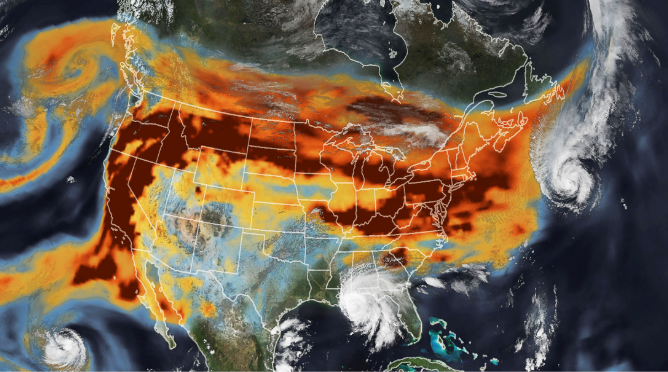The Topline: Remembering the year in wildfire smoke

By Christopher Ingraham
Welcome to The Topline, a weekly roundup of the big numbers driving the Minnesota news cycle, as well as the smaller ones that you might have missed. This week: the toll of 2023’s wildfire smoke; counties reconsider their forfeiture practices following Supreme Court decision; the municipal liquor store year in review; a perilous start to ice season; and a Japanese company looks to buy U.S. Steel.
You (yes, you) smoked 90 cigarettes this year
Axios put together a really nice special report on our year of wildfire smoke, and Torey Van Oot wrote a separate piece on how things shook out for Minnesota specifically.
“In the Twin Cities, the cumulative exposure to fine particle pollution this year was the equivalent of smoking 89.8 cigarettes,” she writes. Cumulative smoke exposure was even worse in the northern half of the state. (That’s four-and-a-half packs, or three or four days in the life of Don Draper and other famous smokers.)
Overall 2023’s fire season “more than doubled the previous record for air pollution in the U.S.,” Axios found. Blame Canada.
Minnesota counties lamenting loss of forfeiture profits
MPR News reports on the fallout from a May U.S. Supreme Court ruling that a Hennepin County woman’s rights had been violated when the county sold her condo over back taxes and pocketed all the additional money the sale generated.
Turns out this is a fairly common practice across the state. St. Louis county alone made over $7 million in profit selling forfeited properties between 2017 and 2021. That sum is on top of the back taxes they were owed.
APM’s fantastic research lab crunched some additional numbers and found that counties generated the most profits by forfeiting and selling properties in poor and racially diverse neighborhoods. Seems bad!
Fortunately that’s all in jeopardy now thanks to the U.S. Supreme Court ruling, which has left some counties wondering how to patch the forfeiture-sized holes in their budgets.
The state auditor’s analysis of municipal liquor operations is out!
Minnesota is somewhat unusual for its robust network of city-owned bars and liquor stores. Each year the state auditor — that’s Julie Blaha, who was reelected last year and should not to be confused with the legislative auditor — puts together a report on their finances to ensure local taxpayers are getting a good return on their investments.
This year’s report shows that municipal liquor profits are down, to a total of $27 million across the state’s 211 city-run establishments. Thirty-one cities, nearly all of them in greater Minnesota, reported net losses for 2022. Overall sales were up but so were expenses, so the report recommends that local decision makers review their stores’ pricing structures, inventory control and other factors.
Ice not safe yet, according to dozens of guys drifting away from shore
Last night the Beltrami County Sheriff’s Office had to rescue dozens of ice fishers stranded on a huge floe on Upper Red Lake. The wind kicked up late in the afternoon, causing the ice shelf they were on to break off and start drifting away from land.
You’ll recall something similar happened last year, although that episode happened at the end of November. That suggests that this year’s ice season is running about three weeks behind last year’s.
“Unfortunately, this is a common event for emergency responders in Beltrami County,” a county representative told the Star Tribune last night.
Japanese company buying U.S. Steel for $14 billion
U.S. Steel is being acquired by Nippon Steel in a massive $14 billion deal. That price is roughly double the $7.3 billion buyout offered by domestic competitor Cleveland Cliffs earlier this year.
U.S. Steel employs hundreds on the Iron Range. As of right now it’s unclear what ramifications, if any, the deal will have for those workers or their communities. But the deal is a reminder that there’s still a lot of wealth buried in northeast Minnesota’s hills and valleys, and that enterprising businesses are going to continue looking for ways to dig it up.
Minnesota Reformer is part of States Newsroom, a network of news bureaus supported by grants and a coalition of donors as a 501c(3) public charity. Minnesota Reformer maintains editorial independence. Contact Editor Patrick Coolican for questions: info@minnesotareformer.com. Follow Minnesota Reformer on Facebook and Twitter.



Comments ()